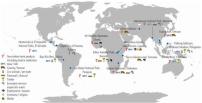
Understanding how people experience poverty locally is essential in identifying how biodiversity conservation can help improve their livelihoods. BirdLife Partners have worked with communities at Important Bird and Biodiversity Areas (IBAs) to develop site-specific solutions to the problems they have identified.

Human wellbeing is dependent on biodiversity and ecosystem services. Damage to ecosystems like forests, wetlands, coral reefs, grasslands or others, due to habitat fragmentation or loss, poses a grave danger to biodiversity and human existence. Whilst all of us depend on the environment, this dependence is most direct and immediate for the poor. Very often the place where they live is their source of food, fuel, medicines, shelter and income, and when habitats become degraded they have no alternatives. Poverty has many other dimensions to it other than low income, and experiences of poverty vary from place to place (BirdLife International, 2006). The Organisation for Economic Co-operation and Development (2001) defines five core dimensions of poverty: economic, human, political, social-cultural and protective.
The BirdLife Partnership endeavours to understand and address poverty, where it affects people living at Important Bird and Biodiversity Areas (IBAs), through “Participatory Poverty Assessment” with local communities. This provides a forum for people to explain how they experience poverty, and in particular to describe their relationship with their environment (the IBA) and its resources. Through this process, BirdLife Partners in Africa, the Americas and Asia have worked with communities to develop site-specific solutions to the problems that have been identified (BirdLife International 2006). Examples include supporting agricultural development around Kabira National Park, Burundi, to help reduce pressure on the park’s land and resources, developing ecotourism to generate income at San Marcos, Bolivia, and improving management and marketing of non-timber forest products in Palas Valley, Pakistan. The process has also confirmed the multi-dimensional nature of poverty, which is recorded through experiences as diverse as an inability to send children to school (at Rukoma IBA in Ghana), feelings of isolation and lack of attention from government (communities in the Bay of Panama IBA) and poor housing (Truong Son, Vietnam).
Conversations with communities also revealed the strong links between people’s livelihoods and the environment and, in many cases, the importance of the IBA in helping to reduce vulnerability and assist with coping in times of stress. These ‘voices of the poor’ at IBAs demonstrate that it is important to ensure that the opportunities and risks associated with environmental issues are included in Poverty Reduction Strategies, and indicate that national and global policy measures are needed to support sustainable local livelihoods.
References
Compiled: 2008
Recommended Citation:
BirdLife International (2008)
Understanding local needs: the role of Important Bird Areas in peoples livelihoods.
Downloaded from https://datazone.birdlife.org/sowb/casestudy/understanding-local-needs:-the-role-of-important-bird-areas-in-peoples-livelihoods on 22/12/2024